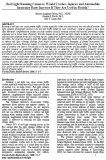Article from: www.thenewspaper.com/news/25/2551.asp
9/30/2008
University of South Florida Red Light Camera Report Clarified
University of South Florida researchers respond to objections to a report questioning the effectiveness of red light cameras.
 A series of objections to a Florida Public Health Review journal analysis of red light cameras sheds new light on the the controversial devices (view original report). University of South Florida Professors Barbara Langland-Orban, Etienne E. Pracht and John T. Large had concluded in March that the most often cited traffic camera studies were unreliable. This drew a sharp response from industry advocates.
A series of objections to a Florida Public Health Review journal analysis of red light cameras sheds new light on the the controversial devices (view original report). University of South Florida Professors Barbara Langland-Orban, Etienne E. Pracht and John T. Large had concluded in March that the most often cited traffic camera studies were unreliable. This drew a sharp response from industry advocates.
"Recently there has been considerable press coverage of a study published by Langland-Orban, Pracht, and Large who are at the University of South Florida that argues against the installation of photo enforcement to curb red light running," wrote Edward A. Mierzejewski. "As Director of the USF Center for Urban Transportation Research I feel compelled to offer some contrary evidence... A recent Iowa State University [study] showed dramatic reductions in both violations and crashes after the installation of red light cameras for both rear end crashes and for right angle crashes."
Professor Orban and her research team responded with a new analysis of the Iowa study that noted a number of deficiencies. Results for the city of Clive were not based on a comparison of effects before cameras were installed to the situation after the devices were activated. Instead, only "violations" were counted -- a factor wholly in the control of the camera vendor. Results for Council Bluffs were based on a single year's worth of data after camera installation, an amount insufficient to support a scientific conclusion. Davenport's results reported as "statistically significant" turned out to reflect a difference of 0.01 crashes per quarter at all camera intersections (Table 6-24), which cannot properly be considered significant.
A physician writing in the journal objected to the Orban report by suggesting that mentions of insurance industry involvement in red light camera promotion amounted to pure speculation and conspiracy theory rooted in paranoia.
"Automotive insurance is a for-profit industry, but the researchers neglect to emphasize a possible goal of decreasing accident payouts, and instead focus on red-light cameras as convoluted schemes to increase premium rates," Daniel R. Retzer, MD wrote.
Orban's response was simple: no conjecture is needed. The Insurance Institute for Highway Safety (IIHS), wholly funded by the insurance industry, has a red light camera advocacy section on its website that features official testimony urging state legislators to adopt red light camera legislation. Moreover, the site's use of statistics raised questions about the scientific objectivity of IIHS. Instead of saying that less than five percent of traffic fatalities were attributed to red light running, for example, IIHS asserted that ignoring traffic signals caused 22 percent of all crashes and, of these, 24 percent were attributed to red light running. The only purpose of citing the larger figures would be to make it appear as if one-fifth of traffic fatalities are caused by red light running when the true figure is less than one out of twenty. Such tactics are not unique.
"With regard to cameras, the IIHS behavior is similar to the tobacco industry in that both industries conducted their own research via a separate 'scientific' institute, which was used to advance a product (cigarettes) despite independent research producing contrary conclusions that raise health and safety concerns," Orban wrote. "This strategy is unfortunate in that the questionable camera research and opposition to independent research could tarnish the good work the IIHS has conducted in studying crashes. Meanwhile, camera vendors systematically use IIHS information in efforts to change state laws and advance camera use."
Orban and the research team went on to show that between 2000 and 2004, Florida automobile insurance providers experienced a 23 percent annualized increase in the rate of underwriting profit while payments on claims increased from $6.4 billion to $8.5 billion. With no decrease in payouts, increased premium rates were the only possible source of the substantial growth in profit.
No other objections were made to the heart of the Orban report's findings.
"In our original analysis, we found the two pro-camera studies grossly deficient, in part, because they did not conduct before-and-after evaluations at camera intersections and did not report changes in red-light running or total crashes and injuries," Orban wrote. "Of the criticisms we have received to date, none have claimed that we incorrectly presented information from these studies."
Orban's response concluded by suggesting a return to an emphasis on a systematic approach to traffic safety based on automobile and roadway engineering would be demonstrably more effective than a single-minded emphasis on enforcement.
Source: Red Light Cameras - Reader Reaction and Author Reply (Florida Public Health Review, 5/29/2008)
Permanent Link for this item
Return to Front Page
 A series of objections to a Florida Public Health Review journal analysis of red light cameras sheds new light on the the controversial devices (view original report). University of South Florida Professors Barbara Langland-Orban, Etienne E. Pracht and John T. Large had concluded in March that the most often cited traffic camera studies were unreliable. This drew a sharp response from industry advocates.
A series of objections to a Florida Public Health Review journal analysis of red light cameras sheds new light on the the controversial devices (view original report). University of South Florida Professors Barbara Langland-Orban, Etienne E. Pracht and John T. Large had concluded in March that the most often cited traffic camera studies were unreliable. This drew a sharp response from industry advocates.